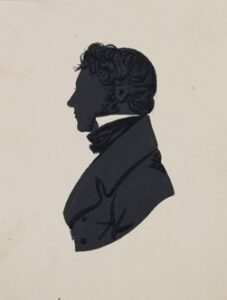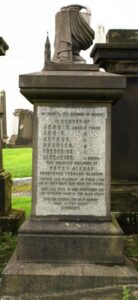Written by Ann O’Connell and Morag T Fyfe
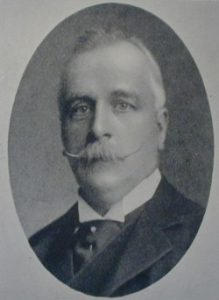
Robert Easton Aitken
Robert Easton Aitken, often referred to as Colonel R E Aitken, was a well known citizen of Glasgow in the second half of the 19th century thanks to his position in the Glasgow Stock Exchange and as a member of the Volunteers. He was a burgess of the City of Glasgow like his father, grandfather and great grandfather before him.
He was born in Glasgow on 27th December 1842 the second child and eldest son of Robert Aitken and Catherine Mary McNish. He had two brothers and three sisters. His younger brother, George David Aitken, born in 1846, died young. His youngest brother, Charles King Aitken (1848/54-1940), was a member of to the Glasgow Stock Exchange Association like his father and elder brother. Aitken’s three sisters were Catherine M Aitken, born 1841, Agnes J Aitken, born 1851 and Margaret E Aitken, born 1854.
R E Aitken attended the Grammar/High School which between1821 and 1878 was located in John Street. He was in Fletcher Low’s 1852-1857 class. Some sources claim he attended Glasgow University but there is no evidence that he graduated, though it is possible he attended some few classes and left without graduating.
Aitken trained as an accountant in his father’s firm Aitken & Mackenzie. He is also said to have trained as a civil engineer including twelve months in Berlin. In 1869/70 he was admitted a member of the Institute of Accountants and Actuaries in Glasgow (IAAG), and of the Glasgow Stock Exchange Association. When his father retired in 1870 he replaced him in the firm which eventually became Aitken, Mackenzie, & Clapperton, and of which he became senior partner in 1880. Although trained as an accountant Aitken, like his father before him, was best known as a stockbroker. He was a member of the Stock Exchange for thirty-nine years, and was elected chairman five times, in 1889, 1890, 1891, 1898, and 1903. He was also a director of several public companies, and a J.P. for the County of the City of Glasgow and for Dunbartonshire.
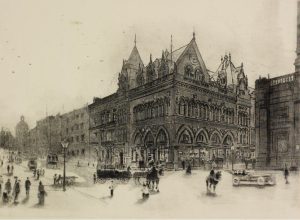
The Glasgow Stock Exchange on the corner of St George’s Place (since 1986 Nelson Mandela Place) and Buchanan Street, c 1900. The Exchange was founded in 1844. The architect John Burnet designed this building in the Venetian Gothic style. It was erected 1875-1877 and an extension was added in St George’s Place in 1906.
Glasgow University Library, Special Collections
A keen weekend soldier, Aitken served with the local Volunteers for many years. He is said to have spent two years in the Queen’s Edinburgh Rifle Brigade, before joining the 1st Lanarkshire Rifle Volunteers (1LRV). He was commissioned Lieutenant in 1LRV in December 1869, Captain in February 1871, Major in January 1880 and Lt Colonel in December 1881. He retired in 1888 with the rank of Honorary Colonel, which he retained by permission, and in November 1892 was one of the first recipients of the Volunteer Decoration.
Aitken can be traced in most of the censuses living at first at the family home in Bath Street (identified in the 1871 census as number 201). At the time of the 1861 Census he was there with his parents, brother Charles, sisters Catherine, Agnes and Margaret, two unmarried Aitken aunts and four servants.
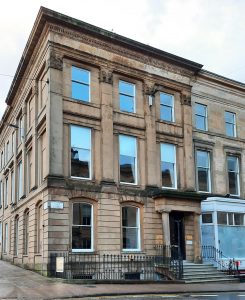
201 Bath Street (2020)
In the 1871 Census Aitken, two unmarried sisters (Agnes and Margaret) and three servants were still living in the Bath Street house but their parents were not present as they may have retired to Largs by then.
On 7 March 1872 Robert Easton Aitken and Olivia Augusta Jones married in Marylebone, London where Olivia was living at the time. Olivia, born in Glasgow on 18th January 1845, was the only surviving daughter of Jesse Jones, a British subject born in Bermuda in 1815 who settled in Glasgow as a West India Merchant, and of Christina Croil originally from Glasgow.
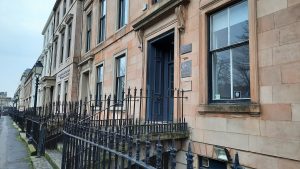
5 Somerset Place (2020)
By 1881 Aitken and his wife can be found at 5 Sumerset (sic) Place, Glasgow with two daughters Olivia and Eleanore and three servants.
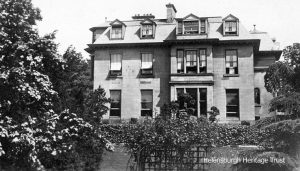
Lansdowne Park, Victoria Road, Helensburgh, now demolished.
Olivia died on 7th August 1890 aged 45 and it turned out that sometime between 1881 and her death in 1890 the family had moved out of Glasgow to Lansdowne Park a large detached villa in Helensburgh. Aitken himself was not at home on the night of the census but his three children (a son, Seymour, aged four had joined the two daughters) were being cared for by two McBride cousins of the family. There seems to be a family connection with Rothesay considering that Seymour was born there, the two cousins come from there as do two further visitors. The family had three indoor servants and a gardener.
In the 1901 Census Aitken, was still living at Lansdowne Park, Victoria Road, Helensburgh with his twenty three year old daughter Elenore. Seymour who would be about fifteen by this time is not there but at Uppingham School. There were now five servants employed in the house.
During his life Aitken found time to travel widely in the United States, Canada, and Europe and this may explain why he was not at home on census night 1891.
In politics he was a Liberal Unionist, serving as vice-chairman of the Dumbartonshire Liberal Unionist Association in 1900.
When resident in Glasgow, Aitken was a member of Free St. Matthew’s Church, Bath Street although it is not known whether he was ever an elder. In the early 1900s newspaper reports show that he opposed the union of the Free Church with the United Presbyterian Church to form the United Free Church which took place in 1900. In the prolonged wrangling and court cases which followed he used his financial expertise to support the minority part of the Free Church which remained outside the union and sought to reclaim many of the assets taken over by the United Free Church at the Union.
He died at Helensburgh on 4th January 1923 aged 81 and is buried in Glasgow Necropolis Compartment Epsilon. The lair seems to have belonged to his father in law, Jesse Jones, who is buried there along with his wife. Aitken was predeceased by his wife Olivia and a three year old daughter Evelyn Mary Gibsone who died in 1879,
He left an estate to the value of £20,982 : 14 : 7 in 1923 terms.
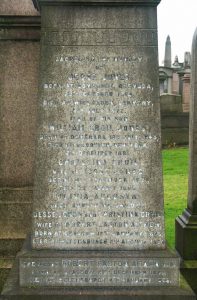
Robert Easton Aitken – Grave
Sacred to the memory
of
JESSE JONES
born at Somerset Bermuda
20th October 1815
died at Wiesbaden Germany
6th July 1872
Also of his son
WILLIAM CROIL JONES
born at Demerara 12th July 1843
died at Brooklyn, New York
8th December 1881
CHRISTINA CROIL
wife of JESSE JONES
born 29th December 1821
died 28th August1886
OLIVIA AUGUSTA
last surviving child of
JESSE JONES and CHRISTINA CROIL
wife of ROBERT EASTON AITKEN
born at Glasgow 18th January 1845
died at Helensburgh 7th August 1890
The above ROBERT EASTON AITKEN, C.A.
born at Glasgow 27th December 1842
died at Helensburgh 4th January 1923
EVELYN MARY GIBSONE
daughter of
ROBERT EASTON AITKEN
born 22nd June 1875
died 9th May 1879
The Aitken family’s burial place was in the Ramshorn churchyard where Robert Easton Aitken and Robert Crichton Seymour Aitken restored the grave stone in 1907. The stone commemorates Aitken’s grandfather, another Robert, who died on 5th July 1833 aged 68 and his wife Agnes Easton died 1847 at the age of 77. This Robert Aitken was a cloth manufacturer and manager of the Bank of Scotland in Glasgow when the head office was successively in Miller Street and Ingram Street, He was also an original member of the Western Club, and was intimately acquainted with the leading city men of his day. The military tradition of the family may have started with this Robert whose gravestone states that he was first lieutenant in the First Regiment of Royal Glasgow Volunteers 1797.
Aitken’s father, yet another Robert Aitken (1806 – 1890), was in 1844 an original member of Glasgow Stock Exchange, and was for three years chairman of that institution. The IAAG formation records indicate that he entered public accountancy practice prior to 1841 and initially partnered IAAG founder Thomas Gray Buchanan in Glasgow. It is said his father served in the Glasgow Sharpshooters about the time when it was disbanded. If so he must have been a young man at the time as this is the regiment raised in 1819 and disbanded in 1824 and commanded by Samuel Hunter, editor of the Glasgow Herald. The Ramshorn gravestone records that this Robert Aitken was buried in Sighthill Cemetery in 1890 along with three of his sisters but there is no mention of his wife, and R E Aitken’s mother, Catherine McNish.
Sources
Glasgow Stock Exchange Reference: Glasgow University Library Special Collections, e190
Glasgow University Library, Special Collections
Seekers of Truth: The Scottish Founders of Modern Public Accountancy by T.A. Lee (Studies in the Development of Accountancy Thought vol 9), 2006
The Town School, A History of the High School of Glasgow by Brian R. W. Lockhart . 2010
Who’s who in Glasgow in 1909
Bannatyne v. Overtoun: en.wikipedia.org/wiki/Free_Church_case#:~:text=Bannatyne%20v%20Overtoun%20AC%20515%20%28also%20called%20General,union%20%28see%20Free%20Church%20of%20Scotland%20%28post%201900%29%29.









